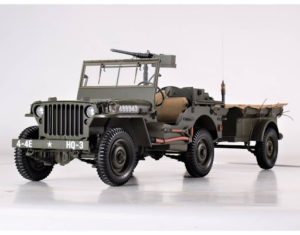
[ad_1]
Thousands of off-road vehicles, mostly American-made, including the iconic Dodge, Chevrolet, or Studebaker tracks practically helped to win the bloody and terrible World War II.

The wars are won primarily by well-organized logistics. The huge tanks, airforces, large army, and other advanced equipment are, of course, good. However, none of these components works effectively without logistics and support from the back. The victory of the Allies during WWII would not be a reality without trucks and other supporting vehicles their armed forces were fully equipped with. Not surprisingly, the American automobile industry changed its outlook with the onset of World War II. Almost all automakers stopped producing new civilian vehicles and proceeded to supply the front line with a variety of automobiles, aircraft engines, and everything that was needed for the victory. Naturally, the main qualities at the front line were functionality, simplicity, and sustainability, including difficult climatic, weather, and terrain conditions. Let’s remember the iconic American automobiles of the Second World War made the victory a reality.
Studebaker US6

Imports from the US into the Soviet Union were banned, of course, and from a national security point of view, the use of foreign equipment in the armed forces could cause serious problems, if not WWII. However, all disagreements were put aside, and Studebakers were sent to the USSR. US6 trucks appeared in the Soviet Armed Forces in 1942 as a reliable carrier for the multiple-launch rocket system “Katyusha”. Durability, unpretentiousness, weightlifting capacity, and AWD allowed the automobile to work in any climate conditions and navigate the Russian off-road.
Ford GPW Willys

The icon of the American automobile industry, the Ford GPW Willys, entered the war in 1942 under the Lend-Lease program. It was used for reconnaissance and the transportation of military commanders of Allied Forces. In addition to transportation, this vehicle was also used as holders for machine guns and other small arms, and sometimes as an ambulance.
Dodge WC-51

This automobile appeared at the height of the war – in 1941. It received the nickname “three quarters” since its carrying capacity was 750 kg, that is, three-quarters of a ton. The Dodge WC-51 was mainly engaged in weapon transportation, but it was also used as a base for radio stations or sanitary points. According to war experts, the Dodge WC-51 was perfect for carrying 57mm anti-tank guns.
Willys МВ

The Willys MB was versatile, and practical classified as a tactical vehicle with a quarter-ton payload. Deliveries of Willys MB cars under Lend-Lease for the Allied Forces began in the spring of 1942. It could be adapted to a variety of military needs, including the installation of special equipment and weapons, towing trailers, and light artillery systems. They came from the USA and Great Britain by three sea routes through the northern, southern, and Far Eastern ports.
Ford GPA

In 1941, the Ford company prepared an amphibious vehicle to compete for a government order for the production of a light-floating automobile with a payload of 250 kilograms. In 1942, the vehicle entered the US Army and later was sent to the Soviet Union under the Lend-Lease program. It was highly appreciated by the Soviet Army: the automobile was able to force water barriers and behaved perfectly in military conditions.
If you like this article, please share it with your friends.
[ad_2]